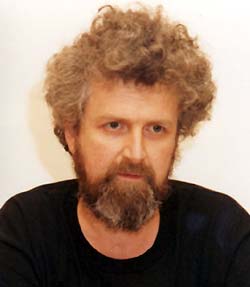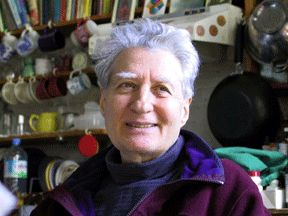In Memoriam Hugh Davies
In Memoriam Jackson Mac Low
Twee goede vrienden, twee schitterende kunstenaars, de ene instrumentenbouwer en performer, de andere klankdichter en Fluxus-artiest, zijn onlangs gestorven.
Zij laten beiden werk na van internationale betekenis en hebben tijdens hun leven een belangrijke bijdrage geleverd aan de hedendaagse, experimentele muziekscene.
Reeds in 1972 was er voor het eerst op het jaarlijkse Mixed Media Festival georganiseerd door Logos, werk van Hugh Davies te horen. Sindsdien was hij regelmatig bij ons te gast en ontmoetten we Hugh ook vaak op vele festivals waar we samen uitgenodigd waren en koncerten verzorgden. Zijn vele zelfbouwinstrumenten, waarop hij sonore mikroskopie toepaste, blijven voor altijd in ons geheugen gegrift en hebben Hugh onsterfelijk gemaakt bij iedere liefhebber van nieuwe klanken en geluiden.
Jackson Mac Low ontmoetten we voor het eerst in New York in 1980. Reeds in 1983 was hij te gast bij Stichting Logos en performde er een aantal van zijn verbazingwekkende nieuwe klankgedichten. Zijn goed gevoel voor humor, zijn vrolijke lach en twinkelende ogen zullen ons voor altijd bijblijven. Nu nog klinkt zijn Milarepa Gata regelmatig in mijn herinnering. In de jaren tachtig verzorgde ik ook een uitzending over hem voor - toen nog - BRT III, in een reeks van de ondertussen ook overleden Freddy Devree en schreef ik een artikelenreeks over New Yorkse kunstenaars, waaronder ook Jackson.
Ten afscheid hieronder een kort overzicht van hun werk.
Hugh Davies
 De eerste instrumenten die Hugh Davies vanaf 1967 maakte, sloten nauw aan bij zijn interesse voor elektronika tijdens de voorgaande jaren. Die eerste instrumenten klonken vaak alsof er live elektronika gebruikt werd. Meestal komt er echter geen elektronika aan te pas. Davies maakt kleine instrumenten die vaak zo stil klinken dat ze enkel hoorbaar gemaakt kunnen worden door versterking. Materialen die gebruikt worden voor deze miniatuur-instrumenten zijn bijvoorbeeld dennenappels, papieren enveloppes, deksels en eisnijders.
Shozyg I (1968) is één van de eerste instrumenten die Davies ontwierp en was bepalend voor zijn latere werk. Een goede reden om het alvast op het programma te zetten. In de kaft van een oude encyclopedie (letters SHO tot ZYG) worden allerlei resonerende objekten gekleefd (veren, metalen staafjes,...) die daarna versterkt worden. Kleine objekten en minimale bewegingen van de uitvoerder produceren zo toch een verrassend geluidsvolume. Spring Song (1970) is een ander oud werk dat past in deze lijn. Verschillende veren worden bevestigd aan een houten raamwerk.
Recenter werk is er te horen op een instrument met de naam "Porcupine". Dit instrument -een dertigtal metalen staafjes van verschillende lengtes- is zowel een akoestisch als elektrisch instrument. In de akoestische versie kunnen de staafjes direkt bespeeld worden (strijken met een zachte borstel of trekken). In de tweede versie wordt het elektrisch circuit van twee toetsenborden met de staafjes verbonden.
De naam "Shozyg" heeft Davies aan een serie soortgelijke werken en instrumenten gegeven. In Shozyg Sequence No. 3 uit 1992 worden verschillende shozyg-instrumenten gebruikt. Allerlei objekten worden gestreken, aangeslagen of geblazen.
Hugh Davies (°1943) is aktief als komponist, instrumentenbouwer, uitvoerend musicus/improvisator en onderzoeker. Na zijn studies in Oxford was hij tussen 1964 en 1966 assistent van Karlheinz Stockhausen in Keulen. Zijn onderzoek naar nieuwe instrumenten en elektronische muziek verrichtte hij achtereenvolgens aan de universiteit Goldsmiths' College en daarna aan de Middlesex University beiden te London.
Als improvisator op eigen instrumenten is hij zowel solo als in groepsverband te horen (o.a. met Max Eastley, Hans-Karsten Raecke, John Russell en Roger Turner). Wereldwijd waren zijn klankinstallaties te zien op 24 solo-tentoonstellingen. Van een dertigtal komposities van Davies zijn CD-opnames gemaakt (solo CD's "Warming Up With the Iceman (2001)", "Sounds Heard (boek + CD 2002)" en "Interplay (1997)".
Hugh was a composer, performer, instrument inventor, lecturer and musicologist. He studied music at Oxford University, 1961-64 (BA). He was the assistant to the composer Karlheinz Stockhausen in Cologne, 1964-66. As a Researcher at the Groupe de Recherches Musicales of the French Radio in 1966-67 he compiled a catalogue of electronic music compositions (see below). 1967-1986 he was the founder-director, and 1986-91 the research consultant, at the Electronic Music Studio, Goldsmiths^(1) College, University of London. In 1986-93 he was the external consultant for electronic musical instruments at the Gemeentemuseum, the Hague. Since 1999 he has been a part-time Researcher in Sonic Art at the Centre for Electronic Arts, Middlesex University, London.
He has been a co-founder of several British and international musical organisations; in 1982-86 he was the first Secretary of the newly-founded International Confederation for Electroacoustic Music.
As a researcher Hugh has specialised in 20th century musical instruments and electronic music. His writings on music have been published in 17 countries and translated into 11 foreign languages. They include the compilation of the Répertoire international des musiques électroacoustiques/International Electronic Music Catalog (1968), chapters or substantial texts in 20 books and exhibition catalogues and contributions to The New Grove Dictionary of Musical Instruments (1984; 305 entries), The Dictionary of Art (1996; 4 entries), The New Grove Dictionary of Music and Musicians (2nd. edition, 2001; 82 entries) and six other dictionaries.
Hugh has always combined practical musical experience with his researches. These largely cover areas of which he has had at least occasional experience, bringing inside practical knowledge to his research, while the deeper historical understanding gained through his researches has often fed back into his creative work.
As a composer, apart from more or less traditionally notated music for conventional instruments, he has primarily concentrated on electronic music (live and on tape) and music theatre, as well as - since 1967 - works for his invented amplified instruments. Among his commissions have been several works for modern dance groups. Hugh's compositions have been performed and/or broadcast in 25 countries. He has invented some 130 concert instruments, sound installations and sound sculptures. Some 50 recordings (LP, CD, cassette and videotape) of his music have been published, both as a composer (24 works, with 6 more in preparation) and as a performer (as interpreter and as improviser, with over 25 mostly group improvisation sessions recorded); his CD of duo and trio improvisations Interplay was voted by the reviewers of The Wire as the third best CD of improvised music released in 1997. A solo CD performed entirely on his invented instrume nts, Warming Up With the Iceman, was issued in Germany at the end of 2001. Sounds Heard , a book of his creative writings (with an accompanying CD), including environmental music projects and sound documentation, was published in the summer of 2002.
Since 1964 Hugh has been a member of several live electronic and improvisation groups. His first amplified instruments were constructed in 1967 as an extension of his work with live electronic music. On his invented instruments he has m ainly played not only as a soloist but also in group improvisations with musicians from many other countries. Since 1971 he has specialised in presenting concerts of composed and improvised music performed entirely on invented instruments and found objects, both as a soloist and in ensembles, including more than 190 solo concerts and lecture-recitals, from 1980 sometimes with a quadraphonic sound system and/or with video close-ups. He is currently a member of Strings With and Without Evan Parker; previous g roups have included Music Improvisation Company, Gentle Fire, Naked Software, The Ferals, Voices from Somewhere and the Electroacoustic Cabaret. In the autumn of 2001 he appeared as a guest soloist with the London Improvisers Orchestra.
Scores of his compositions have been published in 12 journals or in his own limited-edition publications. His sound sculptures and other works have been exhibited in 13 countries (in Europe, Canada and the USA), including 23 one-man shows, and for 10 exhibitions he has acted as a curator, selector or consultant.
Hugh's most recent creative activities included :
- * Tintinnabularia Coloniensis, a specially-commissioned "bell forest" for the underground ruins of the Roman Praetorium in Cologne in November 2001 (4500 visitors during its eight-hour opening).
- * Soft Winds Do Blow at the Sirius Arts Centre in Cobh (Co. Cork).
- * An installation for the Postojna Cave, to be presented during the ISCM World Music Days in Slovenia in September 2003.
Jackson Mac Low
 Jackson Mac Low, born 12 September 1922 in Chicago, was a poet and composer and a writer of performance pieces, essays, plays, and radio works (mainly produced at WestdeutscherRundfunk, Cologne). He was also a painter and multimedia performance artist (often with his wife, Anne Tardos). Author of 26 books, his work has also been published in many anthologies and periodicals and read publicly, exhibited, performed, and broadcast in North and South America, Europe, Japan, Australia, and New Zealand. He has read, performed, and lectured throughout North America, Europe, and New Zealand.
He has taught at many schools, notably New York University (1966-73), and in recent years has taught creative writing at SUNY-Albany (1984), SUNY-Binghamton (1989), Temple (Philadelphia, 1989), UC-San Diego (Regents' Lecturer, 1990), Naropa Institute (Boulder, 1975, 1991, 1994), Schule fuer Dichtung in Wien (Vienna, 1992, 1993), Bard College (MFA program, 1994), and Brown University (1994).
He has received fellowships and grants from CAPS (NY State, 1974, 1977), the NEA (1979), PEN (1974, 1982), the Guggenheim Foundation (1985), the Fulbright Foundation (for New Zealand, 1986), the Queen Elizabeth II Arts Council (N.Z., 1986), the New York Foundation for the Arts (1988), and The Fund for Poetry (1988-89, 1991-92).
His visual works have been exhibited in the U.S., U.K., Canada, Austria, France, Italy, and Australia, most recently at Galerie 1900-2000 (Paris, 1989); Galleria F. Borghese, (Rome, 1990); the "Ubi Fluxus ibi motus" pavilion, Venice Biennale (1990); Institute of Modern Art, Brisbane (1990); Salvatore Ala Gallery (NYC, 1990); Emily Harvey Gallery (NYC, 1990-91, 1991-92); Plug In, Brian Melnychenko, and 1.1.1 galleries (Winnipeg, 1991); Galerie Krinzinger (Innsbruck, 1991); Tapeziererwerkstatt Wolfgang Radeczecki (Vienna, 1991), and in Cork, Ireland (1995).
His recent publications include the books Bloomsday (1984), French Sonnets (1984, 2nd ed. 1989), The Virginia Woolf Poems (1985), Eight Drawing-Asymmetries (1985), Representative Works: 1938-1985 (1986), Words and Ends from Ez (1989), Twenties: 100 Poems (1991), Pieces o' Six: Thirty-three Poems in Prose (1992), 42 Merzgedichte in Memoriam Kurt Schwitters (1994), and Barnesbook (1995) and the compact disc (with Anne Tardos and seven instrumentalists) Open Secrets (1993).




|